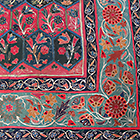Asian Gallery (Toyokan) Room 13
December 3, 2013 (Tue) - March 9, 2014 (Sun)
Cashmere shawls are highest-quality woolen textiles made from the wool of Kashmir goats raised in pastures in the Kashmir region of northwestern India. After the wool is spun into thin, shiny woolen yarn, it is dyed in various colors and then woven into patterns in a tapestry weave. Since Europeans started visiting India, cashmere shawls, which were once worn by the royal family of the Mughal dynasty, became popular in European countries such as England and France. In India, the raised popularity of cashmere shawls led to the production of intricate paisley-patterned shawls, which were favored in Europe, and many of them were exported overseas through the East India Company.
This exhibition features examples of European-taste cashmere shawls in the Tokyo National Museum collection. Also on display are shawls in the collection of the Hirayama Ikuo Silk Road Museum: they include early-period pieces considered to have been worn by Indian royalty in around the 17th century as well as fine pieces with vividly colored designs produced in the first half of the 19th century. It is hoped that visitors will enjoy learning about the great techniques required for producing cashmere shawls and the transition of their designs over time.

